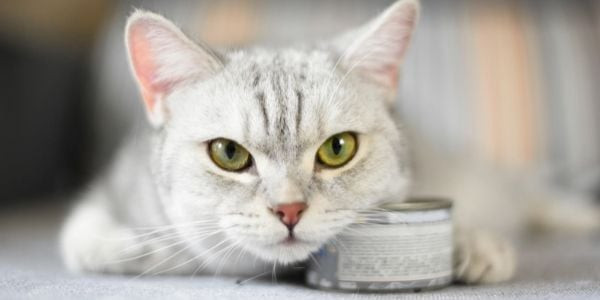 cat not eating lost appetite-shutterFood is more than just sustenance; it’s a source of joy and social connection for both humans and our feline companions. We cherish seeing our cats enjoy their meals, so it can be concerning when they become finicky or lose their appetite. If you’re struggling with a cat that seems uninterested in food, you’re not alone. While cats can be particular eaters, there are often underlying reasons for a decreased appetite that we can address. This guide will explore various methods to stimulate your cat’s appetite and ensure they are getting the nutrition they need.
cat not eating lost appetite-shutterFood is more than just sustenance; it’s a source of joy and social connection for both humans and our feline companions. We cherish seeing our cats enjoy their meals, so it can be concerning when they become finicky or lose their appetite. If you’re struggling with a cat that seems uninterested in food, you’re not alone. While cats can be particular eaters, there are often underlying reasons for a decreased appetite that we can address. This guide will explore various methods to stimulate your cat’s appetite and ensure they are getting the nutrition they need.
How to Encourage Your Cat to Eat
When your cat turns their nose up at their food, it’s time to explore different strategies to entice them. Understanding your cat’s personality and preferences is key to finding the most effective approach. You may need to experiment with several methods, but it’s best to try them individually before combining them.
Optimize Feeding Location, Environment, and Bowl Type
Social Eater or Solitary Diner?
Just like humans, cats have different dining preferences. Some cats enjoy company while eating, while others prefer solitude.
If you have a sociable and affectionate cat, try sitting with them and offering gentle petting while they eat. This social interaction might be the encouragement they need to eat more consistently.
Conversely, if your cat is more independent, they might prefer to eat in peace. For these cats, create a quiet, undisturbed feeding space away from people and other pets. This could be a quiet corner, a closet, or under a bed. Experiment with placing multiple food bowls in different locations to see which spot your cat prefers.
Change the Bowl Location
Cats can be sensitive to their environment. If something negative or frightening happened near their usual feeding spot, they might develop an aversion to that location.
Even when we’re not around, our cats can experience unsettling events near their food. This can make them feel insecure or uncomfortable eating in that area. Try relocating their food bowl to a different part of the room or even a different room altogether. You might need to test several locations to find one where your cat feels safe and happy to eat.
Consider using a Feliway Diffuser near the feeding area. This diffuser releases calming pheromones that mimic those produced by a mother cat, helping to reduce stress and create a more relaxed atmosphere, which can encourage eating.
Experiment with Different Bowl Types
“A bowl is a bowl” – not quite! The type of bowl can significantly impact a cat’s eating experience. If you suspect whisker fatigue (more on this below), opt for a shallow, wide bowl or even a plate. These options prevent your cat’s sensitive whiskers from being compressed against the sides of the bowl, which can cause discomfort.
Stainless steel bowls are generally the best choice. They are durable, easy to clean, and hygienic. Ceramic and glass bowls are also suitable but can break more easily. It’s best to avoid plastic bowls, as they can develop scratches and harbor bacteria, potentially leading to feline acne. Additionally, plastic can emit odors, especially when warmed, which can deter sensitive cats.
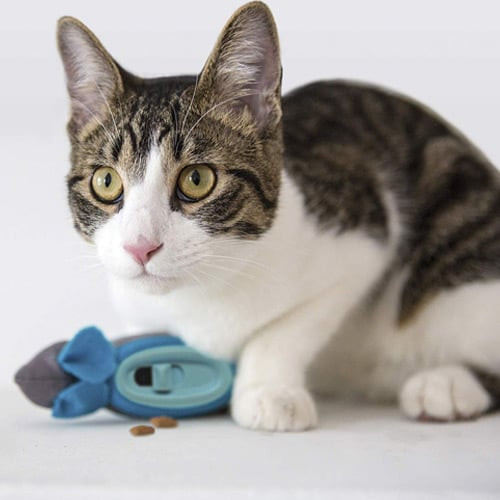 product Doc and Phoebe Indoor Hunting Cat Feeder
product Doc and Phoebe Indoor Hunting Cat Feeder
Go Bowl-Free
To further pique your cat’s interest in food, consider eliminating the traditional bowl altogether. Veterinarian-designed “no-bowl” feeding systems, like the “Doc and Phoebe Indoor Hunting Cat Feeder” pictured, tap into a cat’s natural hunting instincts.
This system uses mouse-shaped feeders that you can fill with a small amount of kibble and hide around the house. This encourages your cat to “hunt” for their food, making mealtime more engaging and stimulating. If you feed both wet and dry food, you could offer wet food in a regular bowl and use the hunting feeders for dry kibble.
Engage Natural Instincts with Alternative Feeding Methods
Cats are natural hunters, designed to eat multiple small meals throughout the day rather than one large meal. Mimicking this natural feeding pattern can be beneficial.
Consider using food puzzles or interactive feeders to dispense small portions of food periodically. These devices encourage your cat to work for their food, providing mental stimulation and preventing boredom. This approach can also help regulate eating habits and prevent overeating, particularly for indoor cats with less opportunity for exercise.
Preventive Vet team review from Chris: “When Rajah and Zsa Zsa weren’t getting along, we realized they lacked mental stimulation, leading to boredom and aggression. The Trixie Mad Scientist Activity feeder was a game-changer. Rajah, who is very food-motivated, loves pawing at it for kibble throughout the day. Even Zsa Zsa, less interested in food, enjoys watching him figure it out.”
Pro Tip: Choose the right dispenser top for the size of your kibble or treats to ensure they dispense correctly – not too easily or too sparingly.
Explore more cat food bowl recommendations.
Discover interactive food puzzles for cats.
Hand Feeding
When all else fails, hand feeding can be a surprisingly effective way to stimulate a cat’s appetite.
Place a small amount of wet food on your fingertip and gently offer it to your cat, dabbing it on their gums if necessary. Avoid force-feeding, as this can create negative associations with food. Alternatively, you can use your cupped hand as a bowl for dry food. Hand feeding is especially effective for social eaters who enjoy close interaction.
Personal Anecdote from a Veterinarian: “I once had a patient who refused to eat. Being a very social cat, I warmed up some particularly pungent canned food. While petting and praising the cat, I pretended to eat the food myself (holding back my own gag reflex!). To my surprise, the cat joined in and took a few bites. It’s not a guaranteed method, but sometimes a little theatrical encouragement can work!”
However, if hand feeding is the only way your cat will eat long-term, it’s crucial to consult your veterinarian. This could indicate an underlying medical or behavioral issue that needs addressing.
Have questions about stimulating your cat’s appetite? Click here to chat with a veterinarian.
Feeding Schedule Adjustments
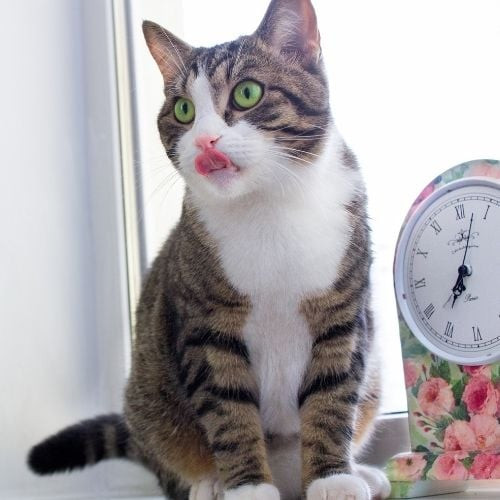 cat waiting to be fed by a clock
cat waiting to be fed by a clock
Let Hunger Build Naturally
Free-feeding, where food is always available, can sometimes lead to a lack of appetite. If your cat is a grazer, try picking up their food for about 12 hours to encourage a healthy sense of hunger.
Establishing a consistent feeding schedule of 2-3 meals per day can help regulate your cat’s appetite. This structured approach helps you monitor their eating habits and ensures they are genuinely hungry at mealtimes. Avoid giving one large meal in the morning, as this can lead to them eating too quickly and vomiting (“scarf and barf”).
Serve Food Fresh
Cats rely heavily on smell and taste to decide what to eat. Just like humans, they prefer fresh food and can be turned off by stale leftovers. Food that sits out, especially wet food, loses its aroma and flavor and can dry out.
Wet food left out for 20-45 minutes (depending on room temperature and food type) can become dry, unappetizing, and attract bacteria and insects. Fresh food is always the most appealing. If your cat hasn’t eaten within 30 minutes, remove the food (refrigerate wet food) and offer it again at the next scheduled mealtime.
Natural, Cat-Safe Food Enticements and Flavors
Cats are known for their discerning palates. They have preferences for smell, taste, texture, and even food temperature. Sudden dietary changes can also be off-putting, especially for cats who are already feeling unwell. Always transition to new foods gradually, particularly if the new food has a significantly different smell or texture.
If you know your cat enjoys specific flavors or textures, stick with those preferences. Familiarity can be comforting and encourage them to eat. Observe your cat’s likes and dislikes as you try these food enhancements:
- Offer Wet Food: Wet food is often more appealing to cats due to its stronger aroma and moisture content. Opt for pungent varieties, especially seafood flavors, which are often irresistible to cats.
Examples of palatable wet food brands with good ingredients include:
Aloha Friends Grain-Free Wet Cat Food for All Life Stages – Seafood with Pumpkin
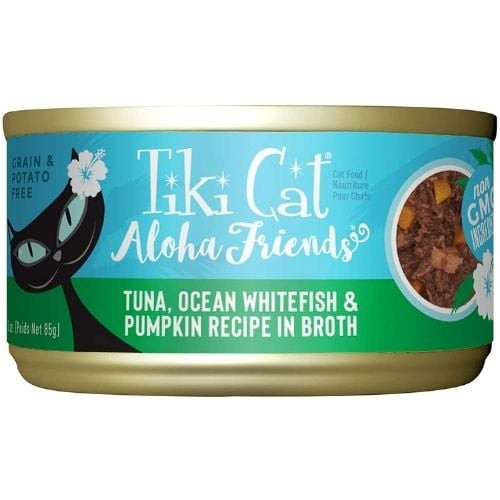 cat food seafood and pumpkin
cat food seafood and pumpkin
Available at:
If you prefer dry food, consider a softer kibble option:
Stella & Chewy’s Freeze-Dried Morsels for Cats – Chicken, Salmon & Chicken, Turkey
 cat food morsels to stimulate eating
cat food morsels to stimulate eating
Available at:
If these strategies are unsuccessful, or if your cat refuses to eat for more than two meals, a veterinary visit is essential to rule out underlying medical issues.
Short-Term Fixes vs. Underlying Issues
If your cat’s appetite returns after implementing these tips, it might be due to a temporary upset stomach, weather changes, or a minor issue. However, persistent appetite loss for more than a day (or less for cats with conditions like diabetes or obesity) requires immediate veterinary attention.
A prolonged lack of appetite can indicate a serious medical condition, and delaying treatment can worsen the situation. Cats who don’t eat are at risk of developing hepatic lipidosis (fatty liver disease), a potentially life-threatening condition.
 Need Help Right Away? Ask a vet now.
Need Help Right Away? Ask a vet now.
Veterinary Prescribed Appetite Stimulants for Cats
In cases where other methods fail, or when a cat is seriously ill and hasn’t eaten for 12-24 hours, your veterinarian may prescribe appetite stimulants. These medications should only be used under veterinary guidance. Common appetite stimulants include:
- Mirtazapine: An antidepressant with appetite-stimulating and anti-nausea effects. Usually given as a tablet every 72 hours, or as a transdermal gel.
- Cyproheptadine: An antihistamine that stimulates appetite and controls nausea. Often used for cats undergoing chemotherapy.
- Diazepam: Less commonly used due to potential liver issues, but single doses can be effective.
- Steroids: Appetite stimulation is a side effect sometimes observed when steroids are used to treat other conditions.
- Vitamin B12 injections: May stimulate appetite in some cases, particularly those not related to chronic gastrointestinal issues.
Importance of Veterinary Evaluation
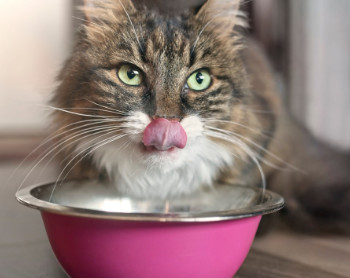 Cat-loss-appetite-shutterProper nutrition is fundamental to a cat’s health and well-being. A balanced diet ensures they receive all the essential nutrients for a healthy and fulfilling life. If your cat’s appetite cannot be stimulated through the methods discussed, seeking veterinary care is crucial. Early diagnosis and treatment of any underlying medical issues are vital for a positive outcome and a quicker return to happy, healthy eating habits.
Cat-loss-appetite-shutterProper nutrition is fundamental to a cat’s health and well-being. A balanced diet ensures they receive all the essential nutrients for a healthy and fulfilling life. If your cat’s appetite cannot be stimulated through the methods discussed, seeking veterinary care is crucial. Early diagnosis and treatment of any underlying medical issues are vital for a positive outcome and a quicker return to happy, healthy eating habits.
The reality is that a medical reason is often behind a cat’s refusal to eat. As you can see in the list below, these medical reasons can range from minor to very serious.
Medical Reasons Why Your Cat Might Not Eat
First, consider if your cat is actually hungry. Remember that cats are small, and some cat foods are very calorie-dense. Depending on their activity level, they might be meeting their energy needs with less food than you expect.
We often project our own eating habits onto our cats. Owners may worry their cat isn’t eating enough based on human portion sizes. However, a veterinarian can assess your cat’s body condition and weight to determine if they are truly underweight.
A Simple Guideline: If your cat is: 1) Eating daily (often when you’re not watching), 2) Maintaining weight, and 3) Acting normally and happy, they are likely perfectly fine! As our video “Feed You Now” humorously shows, hungry cats will make their needs known!
It’s crucial to differentiate between a genuinely decreased appetite due to illness and normal variations in eating habits or pickiness. A cat might stop eating for various medical and non-medical reasons.
Common Medical Causes of Appetite Loss in Cats:
- Dental pain: broken teeth, abscesses, oral tumors, tooth resorption
- Pancreatitis (inflamed pancreas)
- Urinary obstruction
- Digestive obstruction
- Constipation
- Upper respiratory infection (“kitty cold”): reduced sense of smell affects appetite
- Kidney disease
- Liver disease
- Inflammatory Bowel Disease (IBD)
- Esophagitis (inflammation of the esophagus): caused by acid reflux, irritants, vomiting, hiatal hernia, etc.
- Parasites
- Cancer
- Stress or changes in the home environment
Early detection of these medical issues leads to better outcomes and often simpler, less costly treatments. This is particularly important for overweight cats. When obese cats stop eating, they are at high risk of developing hepatic lipidosis (fatty liver disease) due to rapid fat breakdown and liver overload.
For $5, you can consult with a veterinarian about your cat’s appetite concerns. Connect now.
(Rates may vary outside the U.S. 7-day vet access included.)
What is Whisker Fatigue, and Is It a Real Concern?
“Whisker fatigue” is a term you might have heard from veterinarians, pet product companies, or online. While the concept of “tired whiskers” might sound unusual, it’s worth considering, especially if you have a sensitive cat.
We are still learning about the full extent of cat whisker function (vibrissae). While seemingly simple, whiskers are complex sensory organs (learn more about “vibrissae” here).
Whisker fatigue is thought to potentially contribute to appetite issues, mood changes, and behavioral shifts in some cats, adding to their overall stress. We often see whiskers as just facial hair, but they are far more sophisticated. Whiskers are specialized touch receptors with 100-200 nerve cells per whisker. They provide sensory information about the cat’s environment, helping them navigate spaces and understand their surroundings.
Whisker fatigue is theorized to occur when these sensitive whiskers are overstimulated, such as by repeatedly bumping against the sides of deep food or water bowls. This repeated stimulation may cause discomfort, desensitization, and stress.
Over time, this discomfort could manifest as:
- Refusal to eat or drink from regular bowls
- Pacing or meowing near the feeding area
- Attempting to tip over or dig food out of bowls
- Aggression when offered food outside of their usual bowls
The solution to potential whisker fatigue is simple: use wide, shallow bowls or plates. These allow cats to eat and drink without their whiskers touching the sides.
Whiskers are undeniably vital for cats. But is whisker fatigue a genuine phenomenon, or an overblown concern? As cat behavior research evolves, it’s becoming clearer that we may inadvertently create stress for our cats by forcing them into lifestyles that don’t fully align with their natural instincts. Cats are naturally solitary, outdoor hunters. We’ve brought them indoors into a more “pack-like” setting. As responsible owners, we need to minimize environmental stressors and provide adequate enrichment.
The scientific jury is still out on whisker fatigue. Currently, there’s no definitive scientific evidence or studies to confirm it as a recognized condition. The World Small Animal Veterinary Association (WSAVA) stated in 2017 that they have “no information specific to this condition.”
However, the lack of definitive proof doesn’t automatically disprove whisker fatigue. The theory is plausible because whiskers are highly sensitive sensory organs that could become desensitized or fatigued from repeated stimulation, a phenomenon seen in other nerve fibers. Further research is needed to validate the theory.
Do you need to rush out and buy expensive “whisker fatigue bowls”? Not necessarily. Simple low-sided bowls or even plates work just as well.
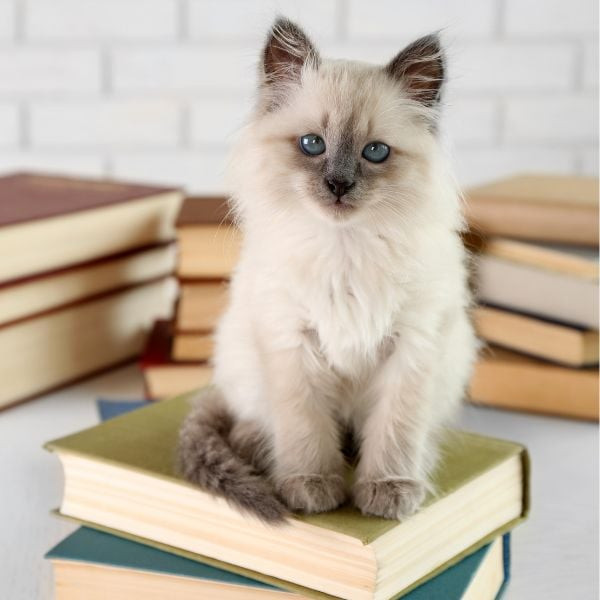 kitten with blue eyes sitting on a stack of books
kitten with blue eyes sitting on a stack of books
Frequently Asked Questions:
Why has my cat stopped eating their usual food?
Many factors can cause a cat to refuse their regular food, including medical issues like kidney disease or GI problems, dental issues, pain, stress, or behavioral changes. If appetite loss lasts over 24 hours, veterinary evaluation is crucial.
How can I tell if appetite loss is due to illness?
Sometimes illness is obvious, but cats are experts at hiding pain and illness. Subtle signs can be easily missed.
What are some common appetite stimulants for cats?
Try warming food or adding palatable toppers like plain chicken baby food (no onion/garlic), low-sodium chicken broth (no onion/garlic), cottage cheese, scrambled eggs, or cooked chicken. Over-the-counter options include Purina FortiFlora, VeteriScience Perio Powder, Virbac Rebound, and Vetoquinol Nutrical. Veterinarians can also prescribe stronger appetite stimulants.
Can stress or anxiety cause appetite loss in cats?
Yes, stress and anxiety can significantly impact a cat’s appetite. Identifying and addressing the source of stress is crucial.
How long can a cat safely go without food?
Veterinary attention is needed if a cat refuses food for over 24 hours. While cats can survive a week or two without food if hydrated, it’s extremely detrimental to their health.
What if my cat refuses wet food?
Try varying the temperature (cool, room temp, warmed). Mix in dry food or treats to increase palatability. If they require a canned-only special diet, try baking it into treats.
Are there home remedies to encourage eating?
Enhance food aroma and flavor by warming it, adding water or low-sodium chicken broth (no onion/garlic), or tuna juice. Pet-specific food toppers and catnip can also entice eating. Feed in a quiet location using a shallow ceramic bowl. Hand-feeding or petting during feeding may help.
How does whisker fatigue affect eating?
Overstimulated whiskers from deep, narrow bowls can cause discomfort and deter eating. Shallow, wide bowls are recommended.
When should I see a vet for my cat’s appetite loss?
Seek veterinary care if your cat stops eating for over 24 hours, especially if they are also not drinking water.
Can home environment changes affect appetite?
Yes, any environmental change (visitors, new pets, sounds, smells) can dramatically impact appetite, immediately or weeks later. What seems minor to us can be stressful for a cat.
What are dehydration signs in cats, and how does it relate to appetite?
Dehydration signs include lethargy, energy loss, appetite loss, constipation, dry/sticky gums, poor skin elasticity, and rapid heart rate. Dehydration can cause appetite loss, and diseases causing dehydration (kidney disease, etc.) often also suppress appetite.
How to make home more comfortable for cats with eating issues?
Place food bowls in quiet, accessible locations, minimizing travel distance. Use shallow, wide ceramic bowls. For dental issues or pain, soften food and discuss pain management with your vet.
How does dental health affect eating, and what are the signs of dental problems?
Dental pain deters eating as cats associate eating with pain. Signs include drooling, bad breath, bloody saliva, head shaking, head/mouth sensitivity, teeth chattering, food dropping, face pawing, decreased appetite, dry food refusal, and weight loss.
Specific dietary needs for older cats with appetite loss?
Senior cats (11+ years) need more protein and fiber due to digestion changes. Feed smaller, frequent meals with high protein, fat, and lower carbohydrates.
Tips for transitioning to new food with a finicky cat?
Transition gradually over 1-2 weeks when the cat is healthy. Mix old and new food, increasing new food percentage over days. Feed in a quiet place, minimize stress, and use calming pheromones.
Do you have stories about your cat’s eating habits? Questions we missed? Share in the comments!
Please help other cat owners by sharing your cat’s food and litter box habits in our anonymous 1-2 minute survey.
Your input is valuable and will help countless cats! Thank you!

